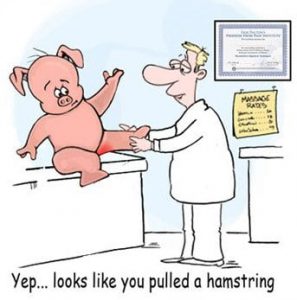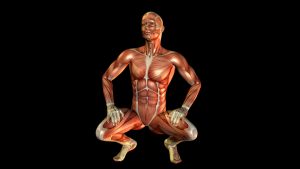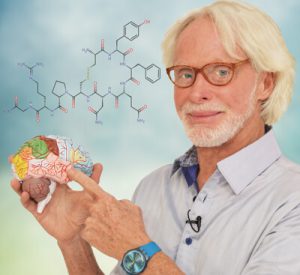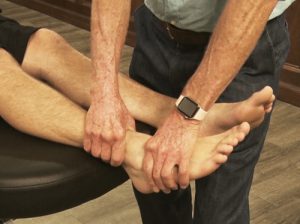
Renowned myoskeletal therapist Erik Dalton, PhD, has a broad therapeutic background in massage, Rolfing and manipulative osteopathy.
 He is widely regarded for his innovative and entertaining pain-management workshops, books, and videos.
He is widely regarded for his innovative and entertaining pain-management workshops, books, and videos.
He is the executive director of the Freedom From Pain Institute, developer of Myoskeletal Alignment Techniques, and author of Dynamic Body: Exploring Form, Expanding Function. (Visit erikdalton.com to read his internationally published articles and to learn more about his unique approach to bodywork.)
When you were a kid, what did you want to be when you grew up?
I’ve always loved performing—my mom was a ballroom dance teacher, and at age 5 I began taking tap lessons. My idol was Fred Astaire, whom Ida Rolf called Mr. Psoas because of the eloquent way he used his core muscles.
I performed in a few high-school musicals, but by graduation I was playing fraternity parties in a rock band at University of Oklahoma.
Our band’s popularity took off, and an LA-based record company asked us to make an album. With the money we made, I was able to complete my psychology grad-school studies. I had no idea bodywork would be my life’s path, but here I am.
How did you get into bodywork?
Our band was playing at a club in Carmel Valley, down the road from the Esalen Institute, and I saw a sign advertising a Fritz Perls (Gestalt psychology) talk that night at Esalen.
By the time I got there, a lady named Ida Rolf was doing a hands-on demonstration. I was fascinated not only by her captivating personality, but also how she was able to make observable changes to this guy’s body in a short demo.
When I got back to LA, I began looking for a Rolfer to help me with a shoulder problem, but I had no luck. A few years later, I was working at the Health Institute of San Diego when I overheard one of the staff members raving about a Rolfer in Del Mar.
I made an appointment right away, and by session three I was pretty much pain free—and hooked on the Rolf method.
By the time session 10 rolled around, I knew I wanted to become a Certified Rolfer.
When did you teach your first workshop?
I held my first workshop in 1994, and back then we called it the “Dalton Attachment Technique.” I’ll never forget that day. My wife Teri and I stuffed 11 therapists in our three-car pink garage, and I remember how thrilled we were that anyone showed up.
In fact, we were so eager to please attendees, we hired a catering company to serve lunch on our terrace overlooking the lake and decorated the whole place like a party. We didn’t make any money on that event, but it encouraged me to continue on the educational path.
Even today, we treat each workshop as an event by booking cool hotels, bringing in our own state-of-the-art audiovisual equipment and supplying participants with full-color booklets with step-by-step instructions detailing all the things we’ll cover that weekend. The goal is to give participants an educational and cultural experience they won’t forget.
How did the Dalton Attachment Technique evolve into Myoskeletal Alignment Techniques?
I’d been in practice as a Certified Advanced Rolfer for several years when I fractured my neck in a clumsy judo fall and lost the use of my left arm. With months of radiating pain and lots of free time on my hands, I began seeking out information on joint neurology.
In my search for answers, I was fortunate to be accepted to study with the legendary Philip Greenman at Michigan State College of Osteopathic Medicine.
After a few years of post-graduate workshops, I was having so much success treating my chronic pain clients that I decided to combine the myofascial and skeletal work and call it Myoskeletal Alignment Techniques, or MAT.
My clients loved the new things I was bringing into my practice, and I began to notice they were standing taller, moving better, and always commenting on how much better they felt. Soon, I became the neck and back go-to guy in Oklahoma City.
Seemingly overnight, my clientele grew to a whopping 36 people a week. So, in 1998, I decided to form the Freedom From Pain Institute and release my first nationally approved MAT home-study course, “Posture Pain Performance.”
Caught off guard by the demand for the course, I rounded up my longtime teaching assistant Kim Miller and hit the road to hold workshops at conventions, massage schools, and any place that asked us to come.
We started picking up skilled bodywork disciples along the way—Paul Kelly came aboard after attending a Nashville workshop, and he’s been teaching with the Freedom From Pain Institute for more than 12 years now.
I’m very fond of all the “Dalton Gang” members who have been with me for so long. As anyone who attends workshops knows, teaching assistants can make or break the experience.
How has the content of MAT changed since you taught your first workshop?
New tools have allowed researchers to uncover a lot more about how the brain inputs, processes and outputs pain—and MAT continues to evolve with each exciting scientific discovery.
Our trainings now include brain-based corrective exercises, hormone activating techniques and neuromobilization maneuvers, as well as the latest concepts in pain science.
MAT practitioners are taught to take clients through a series of deep tissue and graded exposure stretches to help calm hyperexcited nerve receptors and relieve protective muscle guarding.
We’re always stressing the importance of developing keen observation and compassion skills, guided by the principle that the healer is ultimately within each client. We all like to take credit when clients improve, but we must stay humble and remember we’re just facilitators in their healing.
I know you are a lifelong learner, Erik. You never stop learning. Tell me about a recent discovery that has changed your work in some way.
Lately I’ve been learning more about the hormones that help our clients feel better, and I’ve been experimenting with ways to trigger those hormones during therapy sessions.
The acronym DOSE stands for the hormonal quartet of dopamine, oxytocin, serotonin and endorphins—these are the hormones I’m looking to boost.
Dopamine can be stimulated by setting goals the client can achieve. Oxytocin is activated through empathy and trust, so make your clients feel as safe and important as possible. Serotonin is enhanced not only through touch, but also by having the client reflect on past therapeutic achievements.
The research on endorphins seems to indicate that slow, sustained deep touch works best to buffer and help gate the client’s pain.
For more on how neurotransmitter work can trigger a client’s feel-good hormones, check out my blog at erikdalton.com.
Why would someone want to get training in MAT? What are the benefits for a massage therapist?
It’s important to know why we keep seeing the same distorted postural patterns, such as head forward postures, functional scoliosis, pronated feet and valgus knees. We need to remember posture is just a symptom of the underlying problem.
Poor posture tells us the brain and body are not communicating well, but it is not the main event. MAT therapists use brain-based assessments to figure out where the client’s problems are and address them at their core.
Training in MAT allows practitioners to gain basic knowledge of spinal biomechanics and joint neurology for a better understanding of protective muscle guarding. We need to ask ourselves why that knotty shoulder blade spasm keeps returning session after session and whether we want to keep pounding on it.
Remember, the brain may be layering the area with spasm because it senses instability or perceived threat.
So, the short answer to your question is that therapists benefit from MAT programs because they produce positive, observable results that lead to more referrals and better income.
Is it difficult to do MAT? Is it physically difficult to perform?
I designed MAT to fit into any type of bodywork format for practitioners of any size—if they learn to use their bodies properly. At our workshops, I’m always fascinated by the vast improvement in participants’ hands-on skills from day one to day three.
It took me a long time to realize it was not so much what I was teaching them about using their hands as what I was teaching them about using their bodies. Efficient body use is a key focus in all our trainings.
Do you want to comment on the role of home self-care as a way of augmenting your hands-on work and getting better outcomes?
A couple years ago, Paul Kelly and I filmed a home-study course called “Motion is Lotion,” and that title is so true. People have to move to stay healthy and maintain the gains from hands-on work.
Typically, I’ll give my clients three fairly simple corrective exercises to perform once or twice a day. When they return for their next visit, I ask them to show me what they learned.
This not only allows me to observe for quality of movement, but also to praise them for their improvement, which stimulates dopamine. It also lets them know they better be practicing the corrective exercises, because I will be quizzing them!
I also encourage clients to engage in any exercise that is fun. I personally love swimming, hiking, mini trampoline rebounding and any kind of floor exercises.
If someone is interested in using MAT in their practice, where do they start?
I usually recommend starting with one of my three foundational home-study courses, such as “Posture Pain Performance.” This particular program outlines the theory behind the work and focuses primarily on neck and back pain problems.
As osteopathy founder A.T. Still once said, “Learn to fix necks and backs and you’ll always have a full practice.”
For those who prefer in-person workshops to home study, can you tell us what you offer?
I teach one workshop a year in Oklahoma City and also have an annual Costa Rica retreat, called “Pain Management in Paradise.” At our most recent US workshop, I was honored to have Til Luchau conduct a segment on neurogenic headache.
A host of other special guests joined us as well, including Eric Stephenson, Drew Freeman, Sue Hitzmann and Paul Kelly.
Our 19th annual Costa Rica retreat takes place the weekend after Thanksgiving and is now sold out.
However, Paul Kelly will be teaching a bunch of Freedom From Pain Institute workshops in the coming months, and Aubrey Gowing will be conducting MAT workshops throughout Europe. Charlie Peebles also has yearly MAT trainings at Indiana State University, where they offer a minor in massage therapy.
Are there any new and exciting projects you’d like to tell us about?
My creative director Barbara Kardokus and I recently finished putting together a 210-hour Master Myoskeletal Therapist (MMT) certification program, which has been a decade in the making.
Therapists can now earn a “master’s in myoskeletal” through a combination of e-learning courses and 50 hours of live training.
Graduates receive a personal profile page on our website, access to a teachers-in-training program, and soon we’ll be offering a free subscription-based service featuring weekly technique videos, research articles, and a MAT chat room to communicate with fellow MMTs.
I know you still have an active and busy practice. How long have you been practicing?
I graduated massage college in California in 1979 as a requirement for Rolf training and have been in full-time practice ever since.
My wife, Teri, and I have been trying for several years to semi-retire to our Costa Rica home, but my clients are like family, and I find it hard to be away from them for too long.
I might have moved on to another profession long ago had it not been for the constant learning that comes from working with clients.
I love attending workshops and have had the honor to study with some legendary educators, but the hands-on work with my clients has taught me more than everything I’ve learned in textbooks and live trainings combined.
Bottom line: You can’t teach experience!
If you could give therapists one piece of advice, based on your long career in the profession, what would it be?
Keep the passion, folks! We have the best job on the planet, but we must stay engaged as we build our practices.
When the art and fun of bodywork becomes strictly a business, it may be time to reignite the passion by trading sessions with fellow therapists, attending a workshop with friends or upgrading your skill set in your spare time.
I always recommend my e-learning courses because we put so much time and love into them. There are some wonderful programs out there today that will set you apart in your community.
One of my favorite quotes is this: “The truly educated never graduate.”
On sale this week only!
Save 25% off the "Dalton Technique Treasures" eCourse
The “Dalton Technique Treasures” eLearning course is a compilation of some of Erik’s favorite Myoskeletal Alignment Techniques (MAT). Learn MAT techniques to assess and address specific sports injuries, structural misalignment, nervous system overload, and overuse conditions. ON SALE UNTIL July 29th! Get Lifetime Access: As in all our eLearning courses, you get easy access to the course online and there is no expiry date.







